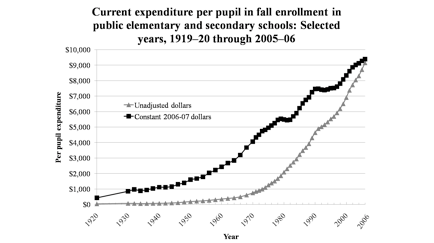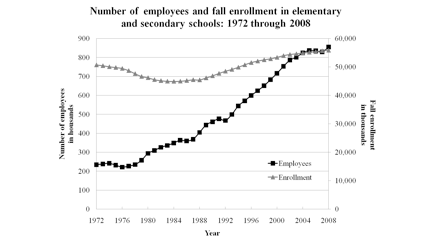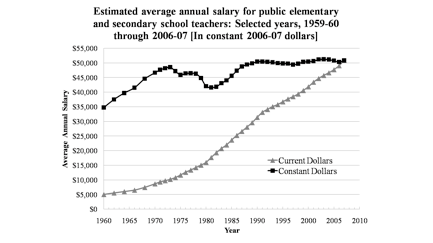America’s schools have always been well funded, despite the claims of school funding advocates who persistently assert that the nation shortchanges its students. That’s the most basic point of “The Phony Funding Crisis,”an article by myself and Arthur Peng that Education Next published on its website today.
As shown in the figure below, per pupil spending has increased in every year for the last century, even when controlled for inflation. (There have been small exceptions, such as during the Great Depression and the early years of the Reagan Administration.) Otherwise, the climb in adjusted per pupil spending has been steady, and even the above-noted plateaus did not involve decreased spending.

The ready availability of money has enabled school districts vastly to increase their supply of professional employees.

Even the salaries of teachers have benefited, though not as much recently as in the past.

These changes have taken place, more money, more teachers, and more purchasing power for teachers, and student achievement has remained stagnant.
Reading scores on the National Assessment of Educational Progress (NAEP) have been level for four decades. And, for a half century, nearly one-third of the nation’s high-school students have failed to graduate with their class each year, while graduation rates for black and Hispanic students are even lower.
As we highlighted in the Education Next media advisory released today:
Even in the current recession, it appears that schools will be protected. The American Recovery and Reinvestment Act (ARRA) has increased the federal government’s contribution to public education from approximately 9 percent each year to approximately 15 percent.
As recent news reports have detailed, over half of the jobs created or saved by the federal stimulus package (325,000 out of 640,000 jobs) have been in public education.
All this federal support, however, could contribute to an even higher trajectory for future spending on public education than has been the case in the past, regardless of the diminishing returns in terms of student outcomes. Based on historic spending trends and estimating that the federal government’s stimulus contribution will grow to approximately $90 billion, we project that national per pupil revenues could increase at a rate of nearly 2.5 percent annually over the next ten years.
The $37 billion in the stimulus package that is intended to offset reduced state and local education revenues, which were down 4.6 percent for the first quarter of 2009, will cushion what would otherwise have been the first significant per-pupil spending reduction in 60 years.
Persistent claims that school districts are in fiscal jeopardy, often reported by the media, are misleading, driven by the fact that school-district budget cycles aren’t synchronized with state and federal legislative appropriations processes. Because it is increasingly rare for legislative bodies to enact spending bills before the beginning of the fiscal year on July 1, school districts, worried about their financial vulnerability and needing to comply with personnel notification deadlines (usually in April or May), issue layoff notices and hold mandatory public hearings, even if the probability of actual personnel layoffs is slender. Such public threats trigger a media frenzy, alarm employees and parent advocates, and fuel the public perception that schools are in financial risk.
Public education revenue has been insulated from the direct effects of economic ups and downs by a number of politically constructed conditions, including a privileged legal status in most state constitutions, multiple state and federal revenue sources, and stable tax support, such as property taxes, at the local level. In most states, too, education employee unions have locked in extended labor contracts, often bridging or outlasting economic recessions, which effectively counter any threat to revenue levels. Additionally, the misguided practice of using spending amounts as a measure of school quality has helped protect local school-funding levels from any effort to reasonably adjust them.


